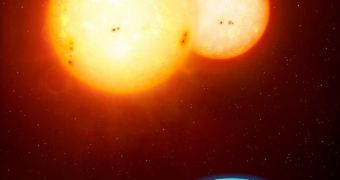In a recent investigation, astronomers at the University of Bristol in the United Kingdom sought to determine how it is that extrasolar planets can form around binary star systems. Previously, this was thought impossible, but data from the NASA Kepler Space Telescope proved that to be false.
A binary system is usually made up of two stars orbiting a common gravity center. Such a system can come in a variety of shapes and sizes, and may consist of different types of objects, from black holes and neutron stars to white dwarfs and red supergiants.
Before the advent of telescopes such as Kepler, astronomers believed that the conditions inside binary systems were simply too extreme to allow for planetary formation processes to occur. However, the planet-hunting observatory was able to detect an exoplanet, called Kepler-34(AB), which proved that these processes are indeed possible.
For all intents and purposes, Kepler-34(AB) is a circumbinary exoplanet, meaning that its orbit encompasses both stars. How this world managed to form from a protoplanetary disk early on in the system's history, despite the powerful gravitational perturbations that the two stars produce, baffles astronomers.
In their latest research, experts with the School of Physics at the University of Bristol, led by expert Dr. Zoe Leinhardt, attempted to provide an explanation for this exoplanet, by using a series of computer simulations of the binary system's early days.
The simulation included around one million objects in the original protoplanetary disk, which is a structure that forms around newborn stars, from excess material that did not collapse into the celestial fireball from its original cloud of gas and dust.
What the team did was basically model collisions between all of these objects, occurring under the effect of peculiar gravitational patterns around the two stars. Results showed that the only possible explanation for the existence of Kepler-34(AB) is that the world formed very far away from the stars.
“Our simulations show that the circumbinary disk is a hostile environment even for large, gravitationally strong objects. Taking into account data on collisions as well as the physical growth rate of planets, we found that Kepler 34(AB)b would have struggled to grow where we find it now,” Leinhardt explains.
This discovery could very well hold true for other circumbinary worlds as well. The fact that planets can migrate within a star system is well known and proven, including in our own solar system.
“Circumbinary planets have captured the imagination of many science-fiction writers and film-makers – our research shows just how remarkable such planets are. Understanding more about where they form will assist future exoplanet discovery missions in the hunt for Earth-like planets in binary star systems,” says astronomer Stefan Lines, the lead author of the new paper.
Details of the work appear in a paper titled “Forming circumbinary planets: N-body simulations of Kepler-34,” which is published in a recent issue of the esteemed Astrophysical Journal Letters.

 14 DAY TRIAL //
14 DAY TRIAL //